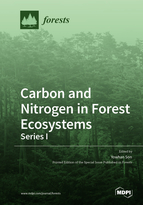Carbon and Nitrogen in Forest Ecosystems—Series I
A special issue of Forests (ISSN 1999-4907). This special issue belongs to the section "Forest Ecology and Management".
Deadline for manuscript submissions: closed (5 April 2018) | Viewed by 48860
Special Issue Editor
Interests: forest ecology; carbon; nitrogen; climate change; soil carbon; carbon dioxide; biogeochemistry; environment
Special Issues, Collections and Topics in MDPI journals
Special Issue Information
Dear Colleagues,
Understanding differences in carbon and nitrogen distributions and cycling spatially and temporally using various approaches is essential in forest ecosystems. In addition, influences of biotic and abiotic factors and natural and artificial disturbances on carbon and nitrogen cycling need to be understood to draw implication to forest management practices.
Relevant matters investigated within this Special Issue will be:
- different approaches to measure carbon and nitrogen distribution and cycling in forest ecosystems including field measurement, remote sensing and modeling;
- differences in carbon and nitrogen cycling within an ecosystem and among ecosystems;
- changes in carbon and nitrogen cycling in forest ecosystems along successional gradients;
- roles of microbes, insects and animals in carbon and nitrogen cycling in forest ecosystems;
- influences of climate change on carbon and nitrogen cycling in forest ecosystems;
- artificial manipulation of trees to simulate carbon and nitrogen cycling to climate change;
- influences of forest management practices on carbon and nitrogen cycling in forest ecosystems;
- ecosystem based forest management;
This Special Issue aims to understand carbon and nitrogen distribution and cycling in forest ecosystem for ecosystem-based forest management under different natural and artificial disturbances.
Prof. Dr. Yowhan Son
Guest Editor
Manuscript Submission Information
Manuscripts should be submitted online at www.mdpi.com by registering and logging in to this website. Once you are registered, click here to go to the submission form. Manuscripts can be submitted until the deadline. All submissions that pass pre-check are peer-reviewed. Accepted papers will be published continuously in the journal (as soon as accepted) and will be listed together on the special issue website. Research articles, review articles as well as short communications are invited. For planned papers, a title and short abstract (about 100 words) can be sent to the Editorial Office for announcement on this website.
Submitted manuscripts should not have been published previously, nor be under consideration for publication elsewhere (except conference proceedings papers). All manuscripts are thoroughly refereed through a single-blind peer-review process. A guide for authors and other relevant information for submission of manuscripts is available on the Instructions for Authors page. Forests is an international peer-reviewed open access monthly journal published by MDPI.
Please visit the Instructions for Authors page before submitting a manuscript. The Article Processing Charge (APC) for publication in this open access journal is 2600 CHF (Swiss Francs). Submitted papers should be well formatted and use good English. Authors may use MDPI's English editing service prior to publication or during author revisions.
Keywords
- Carbon and nitrogen
- Distribution and cycling
- Forest ecosystems
- Field measurement
- Remote sensing
- Modeling
- Microbes, insects, and animals
- Artificial manipulation
- Climate change
- Management practices






